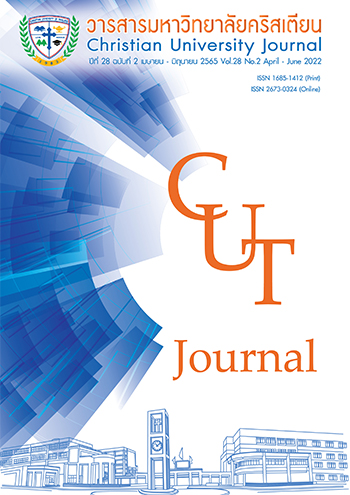ประสิทธิผลของการใช้เทคนิค Ventilator hyperinflation ต่อการเพิ่มการแลกเปลี่ยนแก๊สออกซิเจนที่ปอดในผู้ป่วยที่ใช้เครื่องช่วยหายใจ
คำสำคัญ:
เครื่องช่วยหายใจ, กายภาพบำบัดระบบหายใจ, เทคนิค Manual hyperinflation, เทคนิค Ventilator hyperinflation, การแลกเปลี่ยนแก๊สออกซิเจนที่ปอดบทคัดย่อ
ภาวะเสมหะคั่งค้าง เป็นสาเหตุหลักที่ทำให้เกิดภาวะแทรกซ้อนทางระบบหายใจในผู้ป่วยที่ใช้เครื่องช่วยหายใจ ทำให้การรักษาตัวที่โรงพยาบาลนานขึ้นและค่ารักษาเพิ่มสูงขึ้น เทคนิค manual hyperinflation ถูกนำมาประยุกต์ใช้ในการกำจัดเสมหะ เพิ่มการขยายตัวของทรวงอกและการแลกเปลี่ยนแก๊สออกซิเจนที่ปอด แต่ผู้ป่วยขาดการเชื่อมต่อจากเครื่องช่วยหายใจขณะดูดเสมหะ ส่งผลกระทบต่อการแลกเปลี่ยนแก๊สออกซิเจนที่ปอด เทคนิค ventilator hyperinflation ถูกพัฒนาเพื่อปรับปรุงข้อจำกัดของเทคนิค manual hyperinflation สามารถกำจัดเสมหะ เพิ่มการขยายตัวของทรวงอกและการแลกเปลี่ยนแก๊สออกซิเจนที่ปอด ซึ่งคล้ายคลึงกับเทคนิค manual hyperinflation แต่ผู้ป่วยไม่ขาดการเชื่อมต่อจากเครื่องช่วยหายใจ วัตถุประสงค์ของบทความวิชาการนี้ เพื่อเปรียบเทียบประสิทธิผลระหว่างเทคนิค ventilator hyperinflation และ manual hyperinflation ในผู้ป่วยที่ใช้เครื่องช่วยหายใจ จากการทบทวนวรรณกรรมพบว่า เทคนิค ventilator hyperinflation เพิ่มการแลกเปลี่ยนแก๊สที่ปอดได้มากกว่าเทคนิค manual hyperinflation เนื่องจากผู้ป่วยไม่ขาดการเชื่อมต่อจากเครื่องช่วยหายใจ จึงไม่สูญเสียค่าแรงดันบวกในขณะหายใจออกสุด ส่งผลให้การแลกเปลี่ยนแก๊สออกซิเจนที่ปอดเพิ่มมากขึ้น เทคนิค ventilator hyperinflation ปลอดภัยต่อผู้ป่วยที่ใช้เครื่องช่วยหายใจ
เอกสารอ้างอิง
Ahmed, F., Shafeeq, A.M., Moiz, J.A., & Geelani, M.A. (2010). Comparison of effects of manual versus ventilator hyperinflation on respiratory compliance and arterial blood gases in patients undergoing mitral valve replacement. Heart Lung, 39(5), 437-443. doi: 10.1016/j.hrtlng.2009.10.006.
Anderson, A., Alexanders, J., Sinani, C., Hayes, S., & Fogarty, M. (2015). Effects of ventilator vs manual hyperinflation in adults receiving mechanical ventilation: a systematic review of randomized clinical trials. Physiotherapy, 101(2), 103-110. doi: 10.1016/ j.physio.2014.07.006.
Berney, S., & Denehy, L. (2002). A comparison of the effects of manual and ventilator hyperinflation on static lung compliance and sputum production in intubated and ventilated intensive care patients. Physiotherapy Research International, 7(2), 100-108. doi: 10.1002/pri.246.
Clement, A.J., & Hübsch, S.K. (1968). Chest physiotherapy by the bag squeezing method: a guide to technique. Physiotherapy, 54(10), 355-359.
Dennis, D., Jacob, R., & Budgeon, C. (2012). Ventilator versus manual hyperinflation in clearing sputum in ventilated intensive care unit patients. Anaesth Intensive Care, 40, 142-149. doi: 10.1177/0310057X1204000117.
Hedenstierna, G., Tokics, L., Lundquist, H., Andersson, T., Strandberg, A., & Brismar, B. (1994). Phrenic nerve stimulation during halothane anesthesia. Effects of atelectasis. Anesthesiology, 80, 751-760. doi: 10.1097/00000542-199404000-00006.
Hess, D.R., & Kacmarek, R.B. (2014). Chapter 13: FiO2, positive end-expiratory pressure, and mean airway pressure. In D. R. Hess & R.B. Kacmarek (Eds.), Essentials of mechanical ventilation. (pp.132-142). United States of America: McGraw-Hill Medical.
Hess, D.R., MacIntyre, N.R., Mishoe, S.C., Galvin, W.F., & Adams, A.B. (2016). Chapter 2 mechanical ventilation. In D. R. Hess & N. R. MacIntyre (Eds.), Respiratory care: principles and practice. (pp.462-500). United States of America: Jones & Bartlett Learning.
Hugonnet, S., Eggimann, P., Borst, F., Maricot, P., Chevrolet, J.C., & Pittet, D. (2004). Impact of ventilator-associated pneumonia on resource utilization and patient outcome. Infection Control & Hospital Epidemiology, 25(12), 1090-1096. doi: 10.1086/502349.
Jacob, W., Dennis, D., Jacques, A., Marsh, L., Woods, P., & Hebden-Todd, T. (2021). Ventilator hyperinflation determined by peak airway pressure delivered: a randomized crossover trial. Nursing in Critical Care, 26(1), 14-19. doi: 10.1111/nicc.12498.
Konrad, F., Schreiber, T., Brecht-Kraus, D., & Georgieff, M. (1994). Mucociliary transport in ICU patients. Chest, 105(1), 237-241. doi: 10.1378/chest.105.1.237.
Lemes, D.A., Zin, W.A., & Guimaraes, F.S. (2009). Hyperinflation using pressure support ventilation improves secretion clearance and respiratory mechanics in ventilated patients with pulmonary infection: a randomized crossover trial. Australian Journal of Physiotherapy, 55(4), 249-254. doi: 10.1016/s0004-9514(09)70004-2.
Lindberg, P., Gunnarsson, L., Tokics, L., Secher, E., Lundquist, H., Brismar B, & Hedenstierna, G. (1992). Atelectasis and lung function in the postoperative period. Acta Anaesthesiologica Scandinavica, 36(6), 546-553. doi: 10.1111/j.1399-6576.1992.tb03516.x.
Ntoumenopoulos, G. (2014) Clinical Impact of Secretion Retention. Current Respiratory Medicine Reviews, 10(3), 158-162). doi: 10.2174/1573398X1003150120095050.
Pathmanathan, N., Beaumont, N., & Gratrix, A. (2014). Respiratory physiotherapy in the critical care unit. Continuing Education in Anaesthesia Critical Care & Pain, 15(1), 20-25. doi: 10.1093/bjaceaccp/mku005.
Paulus, F.J., Binnekade, J.M., Vroom, M.B., & Schultz, M.J. (2012). Benefits and risks of manual hyperinflation in intubated and mechanically ventilated intensive care unit patients: a systematic review. Critical Care, 16(4), R145. doi: 10.1186/cc11457.
Ribeiro, B.S., Lopes, A.J., Menezes, S.L.S., & Guimarães, F.S. (2019). Selecting the best ventilator hyperinflation technique based on physiologic markers: A randomized controlled crossover study. Heart Lung, 48(1), 39-45. doi: 10.1016/j.hrtlng.2018.09.006.
Savian, C., Paratz, J., & Davies, A. (2006). Comparison of the effectiveness of manual and ventilator hyperinflation at different levels of positive end-expiratory pressure in artificially ventilated and intubated intensive care patients. Heart Lung, 35(5), 334-341. doi: 10.1016/j.hrtlng.2006.02.003.
ดาวน์โหลด
เผยแพร่แล้ว
ฉบับ
ประเภทบทความ
สัญญาอนุญาต
ลิขสิทธิ์ (c) 2022 มหาวิทยาลัยคริสเตียน

อนุญาตภายใต้เงื่อนไข Creative Commons Attribution-NonCommercial-NoDerivatives 4.0 International License.



